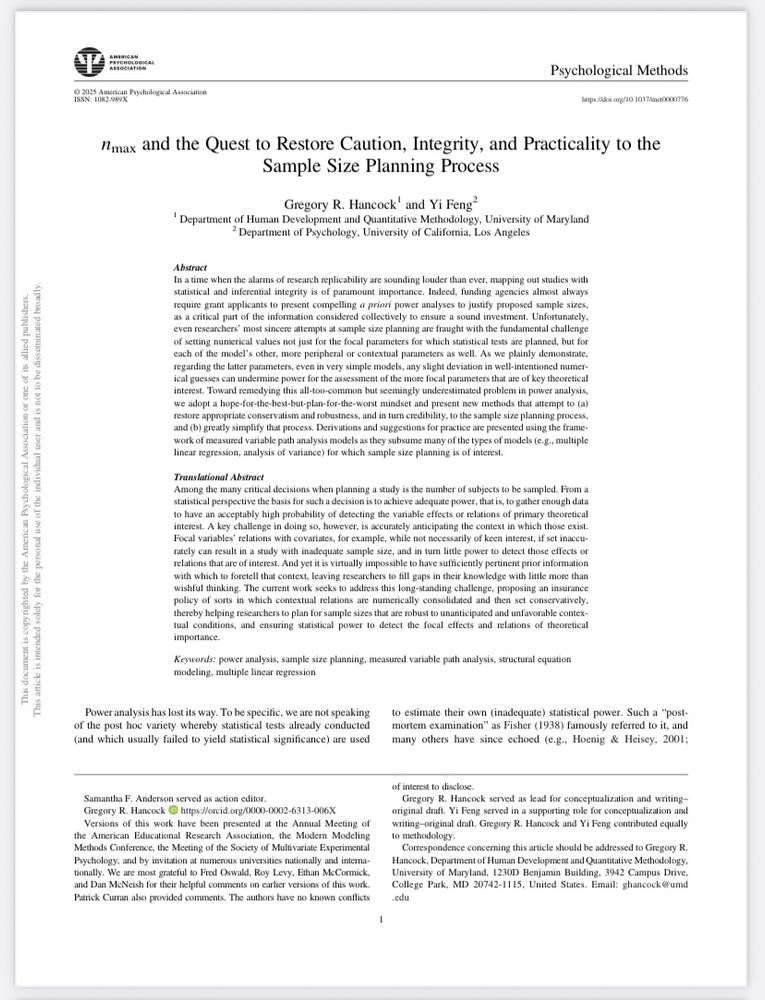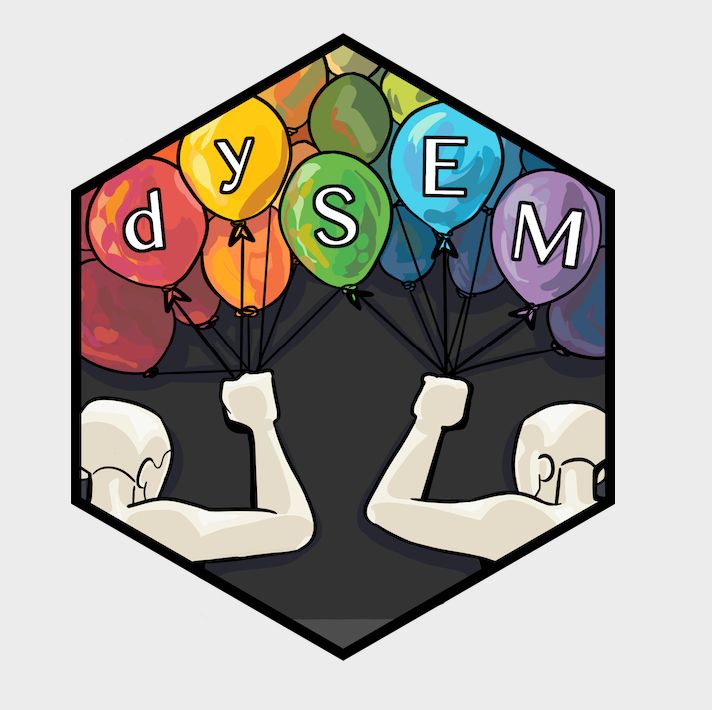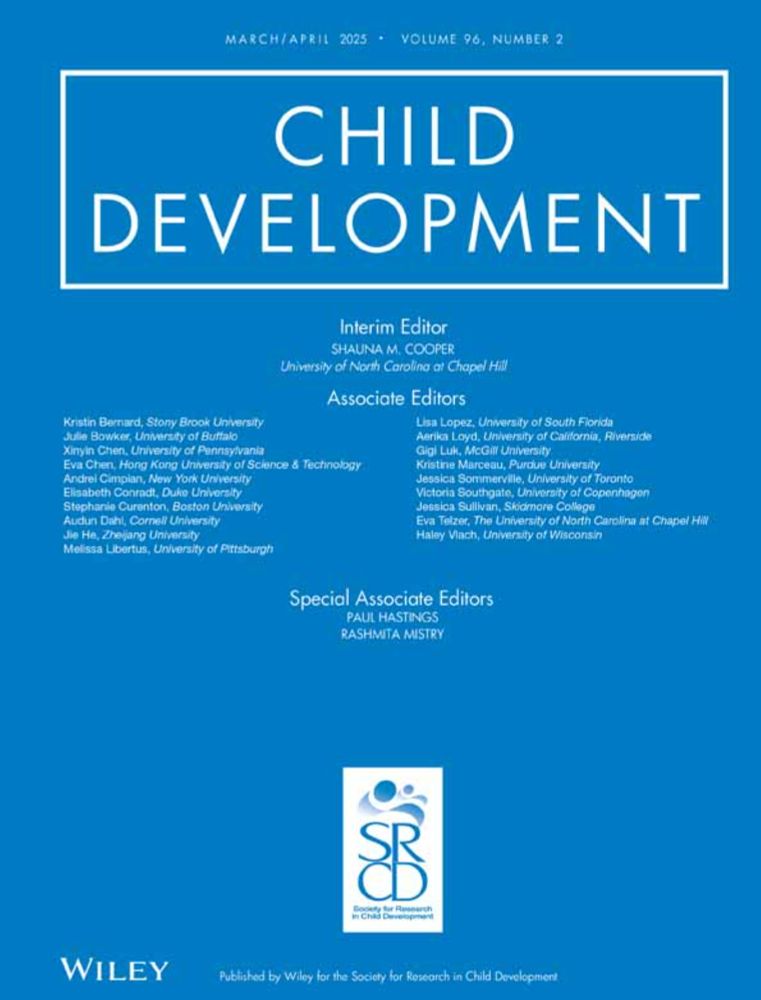We built the openESM database:
▶️60 openly available experience sampling datasets (16K+ participants, 740K+ obs.) in one place
▶️Harmonized (meta-)data, fully open-source software
▶️Filter & search all data, simply download via R/Python
Find out more:
🌐 openesmdata.org
📝 doi.org/10.31234/osf...
22.10.2025 19:34 — 👍 269 🔁 140 💬 14 📌 13

Pseudo Effects: How Method Biases Can Produce Spurious Findings About Close Relationships - Samantha Joel, John K. Sakaluk, James J. Kim, Devinder Khera, Helena Yuchen Qin, Sarah C. E. Stanton, 2025
Research on interpersonal relationships frequently relies on accurate self-reporting across various relationship facets (e.g., conflict, trust, appreciation). Y...
In a new paper, my colleagues and I set out to demonstrate how method biases can create spurious findings in relationship science, by using a seemingly meaningless scale (e.g., "My relationship has very good Saturn") to predict relationship outcomes. journals.sagepub.com/doi/10.1177/...
10.09.2025 18:18 — 👍 170 🔁 75 💬 7 📌 11

For those interested, here is a link to a new power paper:
Hancock, G. R., & Feng, Y. (2026). nmax and the quest to
restore caution, integrity, and practicality to the sample size planning process. Psychological Methods.
yifengquant.github.io/Publications...
19.08.2025 01:04 — 👍 63 🔁 24 💬 4 📌 2

🧵
Very excited (w/ @omarjcamanto.bsky.social) to share our preprint tutorial for using our R 📦 dySEM for #dyadic data analysis with latent variables, in cross-sectional data sets.
This paper has been literal years in the making, and provides three distinct tutorials.
osf.io/preprints/ps...
10.07.2025 14:44 — 👍 57 🔁 25 💬 1 📌 4
These kind of models make lots of assumptions, so make sure not to skip the limitations section if you're considering something like this!
/4
02.04.2025 09:19 — 👍 0 🔁 0 💬 1 📌 0

Trying the model out on the motivating empirical data and made a huge difference, changing the sign and conclusion about the intervention effect (2nd and 3rd row in the image, left vs. right column).
/3
02.04.2025 09:19 — 👍 0 🔁 0 💬 1 📌 0
The paper basically takes the Diggle-Kenward model from growth model in tries to jam it into a multilevel autoregressive model/DSEM.
Some simulations showed that it worked well, was much better than models that assume MAR when data are MNAR, and that it recovers true values pretty well
/2
02.04.2025 09:19 — 👍 1 🔁 0 💬 1 📌 0

New paper on dealing with MNAR intensive longitudinal data. Ran into this problem in an empirical study and didn't find too much in the methods literature on MNAR ILD, so this was the best I could come up with. Lots of opportunity to improve methods in this area!
psycnet.apa.org/record/2025-...
02.04.2025 09:19 — 👍 19 🔁 5 💬 2 📌 0
This work was part of a project funded by the US Dept of Education/IES, which has been a major supporter of pure methods/statistics/psychometrics work in US so that people like me don't have to beg substantive people to tack a methods aim onto an empirical grant
/end
18.02.2025 09:15 — 👍 4 🔁 0 💬 0 📌 0
Goal is hopefully to help researchers be a little more articulate about reporting reliability of scale scores and incorporate more recent ideas from the psychometric literature on conditional reliability when it may be appropriate and complement summary indices like alpha or omega
/6
18.02.2025 09:15 — 👍 0 🔁 0 💬 1 📌 0
The output also provides a number between 0 and 100.
Values close to 100 indicate that alpha/omega represent most scores well.
Values close to 0 indicate that scores have heterogeneous reliability and a summary does not describe some of the sample very well.
/5
18.02.2025 09:15 — 👍 0 🔁 0 💬 1 📌 0

Result is a plot that looks like this -- the conditional reliability at each score (the colored line; color indicates how many people are at that scores) is plotted against the alpha/omega summary index (black line)
/4
18.02.2025 09:15 — 👍 1 🔁 0 💬 1 📌 0

Shiny input looks like this -- upload the data, identify the scale items, the desired coefficient, and choose a method from which to calculate the "reliability representativeness" (different methods discussed in the paper)
/3
18.02.2025 09:15 — 👍 0 🔁 0 💬 1 📌 0
Reliability Representativeness
Basic idea borrows conditional reliability from IRT literature and compares the discrepancy of the conditional reliability function to a single summary like alpha/omega.
Shiny app to implement the method is located at dynamicfit.app/RelRep/
/2
18.02.2025 09:15 — 👍 1 🔁 0 💬 1 📌 0
New paper - coefficients like alpha/omega are commonly reported to summarize reliability. A sneaky nuance is that reliability is actually different at each score in the data. Paper tries to quantify how representative alpha/omega are of a typical score.
link.springer.com/article/10.3...
18.02.2025 09:15 — 👍 24 🔁 7 💬 2 📌 1
OSF
This paper on intensive longitudinal reliability led by Sebastian Castro-Alvarez is one of the best I've read in a while -- the review was so thorough, the code was fantastic, and it answered any questions I had about IL reliability. Definitely check it out you work with ILD!
osf.io/preprints/ps...
29.01.2025 19:39 — 👍 23 🔁 4 💬 1 📌 1

Dynamic Structural Equation Modeling Seminar | Statistics Course
This online course by Dan McNeish Ph.D., introduces both foundational and intermediate topics in DSEM.
Next week, I'm teaching a 3-day workshop on DSEM for intensive longitudinal data using Mplus and registration is still open -- more information about the topics and registration can be found here!
statisticalhorizons.com/seminars/dyn...
29.01.2025 01:41 — 👍 15 🔁 12 💬 0 📌 0
Yes, I think you'd have use Bayesian methods in Mplus. I also don't think you could do a continuous time version in Mplus because I don't think that they've added support for binary variables in continuous time (although I might be behind on what is supported!)
17.01.2025 17:54 — 👍 1 🔁 0 💬 1 📌 0

Missing Not at Random Intensive Longitudinal Data with Dynamic Structural Equation Models
Hosted on the Open Science Framework
The OSF link is here if you’re interested, osf.io/be8h3/
It’s intensive longitudinal data where where the outcome is a binary self-report question on binge eating. There’s 50% missingness and a suspected MNAR process where people don’t respond to the binge eating question when they binge eat
15.01.2025 17:33 — 👍 4 🔁 0 💬 1 📌 0
I made this switch a few years ago and the another thing that came up was that R (at least lme4 ) gives a lot more convergence warnings and errors than SAS, even when the output is identical. McCoach (2018, JEBS) studied this systematically and found similar results.
05.12.2024 20:08 — 👍 2 🔁 0 💬 2 📌 0
I don't understand how you can read and understand an evolving literature without keeping up with methodological developments.
What are we supposed to do, just read discussion sections and take people's word for it?
30.11.2024 16:49 — 👍 42 🔁 7 💬 2 📌 6
The basic principle is that reviewers are tired, they're rushed, they're reading your and 10 other grants on top of their normal workload.
Anything you can do to make it easy for them will help.
Here's a list of my suggestions.
23.11.2024 14:57 — 👍 289 🔁 102 💬 29 📌 25
Who should you nominate as reviewers for your manuscript? After a long chat with a post-grad it appears that there's a lot of misguided advice out there. Thread 👇
22.11.2024 11:05 — 👍 348 🔁 144 💬 18 📌 42
Also, the MI definition in your 2022 preprint was really eye-opening (first found it through @dingdingpeng.the100.ci 's blog). It never struck me that MI could be conceived like that, super clever idea and love when different frameworks help see old ideas in new ways!
15.11.2024 00:12 — 👍 3 🔁 0 💬 1 📌 0
Good point, it would have been nice to see more on the causal perspectives but I thought the history part was fascinating since I have never seen it succinctly presented in one place.
15.11.2024 00:09 — 👍 2 🔁 0 💬 0 📌 0
PhD Student in Psychological Methods (University of Marburg)
Interested in time series, simulation studies & open science
https://bsiepe.github.io
Postdoc @Yale incoming AP @HarvardPsy | context, flexibility, affective psychopathology and resilience to stress/trauma
Assistant Professor of Psychology at College of the Holy Cross. I study how students, teachers, and the public think about education and the implications for improving education. Lab: alexbrowman.com
Academic in Australia studying individual differences, well-being, and performance. Interested in quant methods, #rstats, & open science.
FWO postdoctoral research fellow @ Center for Contextual Psychiatry, KU Leuven in Belgium. Interested in quality of self-report data in ESM/EMA studies and beyond & open science.
Assistant professor @TilburgUniversity | Co-founder of m-Path.io | #EMA / #ESM research | Digital technology in mental health care | DJ
Asst Prof @ UVA Psychology and School of Data Science. Networks, neurons, and complex systems models of psychopathology.
Dedicated to training and dissemination in research methods, statistics, and data science; centerstat.org
Postdoctotal Scholar | Penn State
Assistant Prof of Clinical Psychology @Tilburg University | FWO Senior Research Fellow @KU Leuven | Clinical Psychologist @PraxisP | Associate Editor @SPPE | Studying all things self-injury for better understanding, prevention, and intervention
Assistant Prof at Ohio State / UChicago, OSU, Duke, & UK alum / BPD, DBT, emotion regulation flexibility / CV: bit.ly/4oL4fOM / Scholar: bit.ly/3PMktZT / Lab: u.osu.edu/mattlab/
Quantitative Psych PhD Candidate, U. of Oklahoma
Butler University Alum
psychometrics, variable selection, machine learning, missing data analysis
she/her
Researching alcohol and cannabis use & their etiology. Asst Professor of Clinical Psych @ Arizona State University. Avid Italian chef 🍝 avocado expert 🥑 & stock day-trader 🧮
https://psychology.asu.edu/research/labs/drama-lab
Associate Professor | Quantitative Psychologist | Psychometrician
https://www.psych.mcgill.ca/perpg/fac/falk/
https://scholar.google.com/citations?user=9BA_cL0AAAAJ
Clinical Scientist by training, Yinzer by heart. If I’m not studying risky alcohol use, I’m usually watching soccer (YNWA), cooking, or trying a new craft beer.
Researcher at the Early Childhood Education Institute
Dual-title PhD (Education & HFDS) from Iowa State University
Explores pre-K processes that support DLLs' language & literacy development
https://x.com/CKVanPay
assistant prof. Personalized Treatment Lab @uarizona clinical psychology, intervention science. Precision Mental Health/Digital Therapy. Dad+Husband. He/him.
Personality and organisational psychologist, psychometrician
Facet MAP: https://facetmap.org
Handbook of Psychometrics: https://onlinelibrary.wiley.com/doi/book/10.1002/9781118489772
Profile: https://research.manchester.ac.uk/en/persons/david.hughes-4
special education researcher | 🇨🇴 🇺🇸













